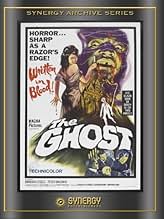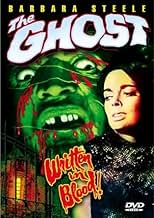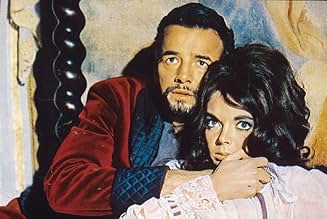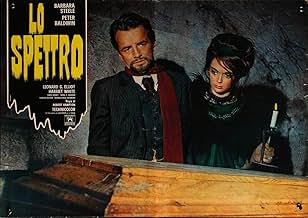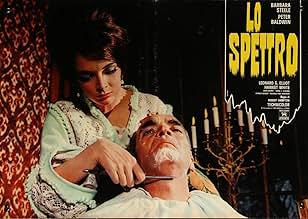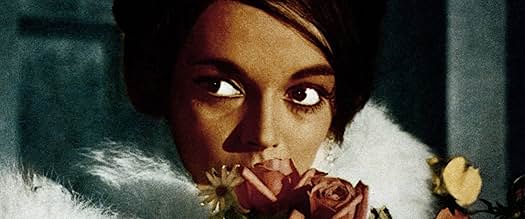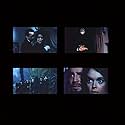IMDb-BEWERTUNG
6,1/10
1494
IHRE BEWERTUNG
Füge eine Handlung in deiner Sprache hinzuA woman and her lover murder her doctor husband, but when strange things start happening, they wonder if they really killed him, or if he has come back from the dead to haunt them.A woman and her lover murder her doctor husband, but when strange things start happening, they wonder if they really killed him, or if he has come back from the dead to haunt them.A woman and her lover murder her doctor husband, but when strange things start happening, they wonder if they really killed him, or if he has come back from the dead to haunt them.
Elio Jotta
- Dr. John Hichcock
- (as Leonard G. Elliot)
Harriet Medin
- Catherine Wood - Housekeeper
- (as Harriet White)
Carlo Kechler
- Police Superintendent
- (as Charles Kechler)
Umberto Raho
- Canon Owens
- (as Raoul H. Newman)
Handlung
WUSSTEST DU SCHON:
- WissenswertesMade during the pseudonym craze of the 1960s, the music score was credited to "Franck Wallace." Italian composers usually registered their pseudonyms with their performing right society, the SIAE, and the identities were listed by Bianco e Nero and the Monthly Film Bulletin who both reported that Wallace was Franco Mannino. However, some reference sources such as Donald C. Willis in 1972 suggested "Franck Wallace" was a joint pseudonym for Mannino and Roman Vlad (the two composers sometimes collaborated and Wallace is a very rough transliteration of Vlad). Even more confusingly, Beat Records released the soundtrack in 2008 and discovered that the surviving tapes in the Nazionalmusic vaults were attributed to Francesco De Masi. So the CD went out credited to De Masi only. De Masi did not work with either of the other two composers, instead being asked at the behest of the director to do a new score, not liking Mannino's effort; what portions thereof are contained in the film, are unknown, as the director seemingly changed his mind again, as Mannino is credited in the film for the score.
- PatzerWhen Dr. Livingston removes the bullet from the wall, there is a close-up of him holding an entire cartridge in his hands.
- Zitate
Dr. John Hichcock: [hands around Margaret's throat] Feel how strong my grip is? But I won't kill you.
- VerbindungenFeatured in 100 Jahre Horror- und Gruselfilme: Ghosts (1996)
Ausgewählte Rezension
This highly-regarded example of the Italian Gothic Horror style had eluded me until now; even so, having caught up with it at long last, I still wasn't done with the 'Curse Of THE GHOST': the Retromedia DVD proved faulty, with a glitch around the one-hour mark (where the image skipped and the audio dropped out) and then experienced complete freezing after 88 minutes - so much so that I had to finish the film off on another player! This was after a public domain copy I rented from Hollywood when I was there in late 2005 (which, on a hunch, I decided to check before watching) reverted to the Main Menu midway through the climax!!
Anyway, the film itself is undeniably a highlight of the genre and one of Freda's best (which he made in just 12 days): a follow-up, not a sequel, to his previous collaboration with star Barbara Steele - THE HORRIBLE DR. HICHCOCK (1962) - despite the re-use of that notorious character's surname. In the earlier film, too, Steele had been overshadowed by a delightfully manic turn from Robert Flemyng but, here, she lives up to her iconic status as the Queen Of Gothic Horror: few actresses have managed to replicate her sensual mix of wickedness and vulnerability; as for the actor playing Hichcock this time around, who looks a bit like Howard Vernon, he's not too bad - if no match, ultimately, for Flemyng.
Like I said with respect to Hammer's FEAR IN THE NIGHT (1972), the plot twists aren't very original - but they make for a great ride regardless; besides, one could just soak in the colorful visuals (even if the print involved features a lot of wear and tear!). Incidentally, the film is rather gory for its time (witness the 'ghost' exhibiting its decaying flesh and the brutal razor murder, with its wonderful device of having blood dripping across the camera lens to simulate the victim's POV), but the lush score (actually a collection of compositions by Francesco De Masi, Franco Mannino and Roman Vlad - billed under one Americanized name, Franck Wallace!) and a reasonable quota of chills (the creepy scenes where the doctor speaks through his faithful and vaguely sinister housekeeper - played by the ubiquitous Harriet White Medin - who, conveniently, doubles as a medium and the various 'apparitions' - wheelchair stumbling down the stairs, dangling corpse) are certainly par for the course...as is, after all, the film's decidedly languid pace.
The deftly ironic climax is very effective - as a self-satisfied Hichcock expounds on his clever machinations while the immobilized Steele looks horridly on, fully knowing that she'll be blamed for the housekeeper's death and, worse still, that she killed her lover for no reason (i.e. he didn't betray her by stealing the jewels, as she had mistakenly assumed, and these were now once more in Hichcock's hands). The English dubbing isn't too bad considering; however, given the story's Scottish setting, it's odd that only one voice actor would deem it fit to attempt a pertinent accent (i.e. the solicitor who reads Dr. Hichcock's will) - which then causes it to seem unintentionally amusing alongside the less heavy inflections of his fellow dubbing artists!
While Freda is often accused of being indifferent to his films (which he often did purely so as to recoup his gambling losses!), he was undoubtedly a pioneer: not only making the first Italian horror effort, but his masterful use of color in the Dr. Hichcock pictures certainly pushed the genre into that corner - after a solitary stab at it by Giorgio Ferroni in MILL OF THE STONE WOMEN (1960) - as few gothics were shot in black-and-white thereafter (notably three films featuring Steele herself, namely CASTLE OF BLOOD [1964], THE LONG HAIR OF DEATH [1964] and NIGHTMARE CASTLE aka THE FACELESS MONSTER [1965]); certainly, Freda's protégé Mario Bava followed his example...and gradually took over the genre!
Anyway, the film itself is undeniably a highlight of the genre and one of Freda's best (which he made in just 12 days): a follow-up, not a sequel, to his previous collaboration with star Barbara Steele - THE HORRIBLE DR. HICHCOCK (1962) - despite the re-use of that notorious character's surname. In the earlier film, too, Steele had been overshadowed by a delightfully manic turn from Robert Flemyng but, here, she lives up to her iconic status as the Queen Of Gothic Horror: few actresses have managed to replicate her sensual mix of wickedness and vulnerability; as for the actor playing Hichcock this time around, who looks a bit like Howard Vernon, he's not too bad - if no match, ultimately, for Flemyng.
Like I said with respect to Hammer's FEAR IN THE NIGHT (1972), the plot twists aren't very original - but they make for a great ride regardless; besides, one could just soak in the colorful visuals (even if the print involved features a lot of wear and tear!). Incidentally, the film is rather gory for its time (witness the 'ghost' exhibiting its decaying flesh and the brutal razor murder, with its wonderful device of having blood dripping across the camera lens to simulate the victim's POV), but the lush score (actually a collection of compositions by Francesco De Masi, Franco Mannino and Roman Vlad - billed under one Americanized name, Franck Wallace!) and a reasonable quota of chills (the creepy scenes where the doctor speaks through his faithful and vaguely sinister housekeeper - played by the ubiquitous Harriet White Medin - who, conveniently, doubles as a medium and the various 'apparitions' - wheelchair stumbling down the stairs, dangling corpse) are certainly par for the course...as is, after all, the film's decidedly languid pace.
The deftly ironic climax is very effective - as a self-satisfied Hichcock expounds on his clever machinations while the immobilized Steele looks horridly on, fully knowing that she'll be blamed for the housekeeper's death and, worse still, that she killed her lover for no reason (i.e. he didn't betray her by stealing the jewels, as she had mistakenly assumed, and these were now once more in Hichcock's hands). The English dubbing isn't too bad considering; however, given the story's Scottish setting, it's odd that only one voice actor would deem it fit to attempt a pertinent accent (i.e. the solicitor who reads Dr. Hichcock's will) - which then causes it to seem unintentionally amusing alongside the less heavy inflections of his fellow dubbing artists!
While Freda is often accused of being indifferent to his films (which he often did purely so as to recoup his gambling losses!), he was undoubtedly a pioneer: not only making the first Italian horror effort, but his masterful use of color in the Dr. Hichcock pictures certainly pushed the genre into that corner - after a solitary stab at it by Giorgio Ferroni in MILL OF THE STONE WOMEN (1960) - as few gothics were shot in black-and-white thereafter (notably three films featuring Steele herself, namely CASTLE OF BLOOD [1964], THE LONG HAIR OF DEATH [1964] and NIGHTMARE CASTLE aka THE FACELESS MONSTER [1965]); certainly, Freda's protégé Mario Bava followed his example...and gradually took over the genre!
- Bunuel1976
- 8. Mai 2007
- Permalink
Top-Auswahl
Melde dich zum Bewerten an und greife auf die Watchlist für personalisierte Empfehlungen zu.
- How long is The Ghost?Powered by Alexa
Details
- Laufzeit1 Stunde 37 Minuten
- Sound-Mix
- Seitenverhältnis
- 1.85 : 1
Zu dieser Seite beitragen
Bearbeitung vorschlagen oder fehlenden Inhalt hinzufügen


